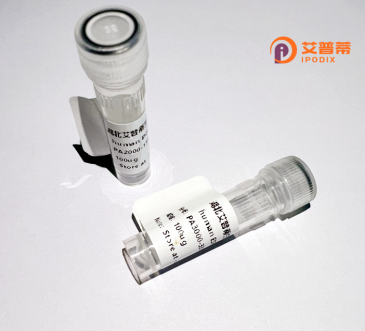
| 纯度 | >90%SDS-PAGE. |
| 种属 | Human |
| 靶点 | ZNF691 |
| Uniprot No | Q5VV52 |
| 内毒素 | < 0.01EU/μg |
| 表达宿主 | E.coli |
| 表达区间 | 1-284 aa |
| 活性数据 | MGSEKEQSPEPHLPEEGEGGKPWRVDDSEGSWIPPGEKEHGQESLSDELQETHPKKPWQKVTVRARELGDPIAHPRHEADEKPFICAQCGKTFNNTSNLRTHQRIHTGEKPYKCSECGKSFSRSSNRIRHERIHLEEKHYKCPKCQESFRRRSDLTTHQQDHLGKRPYRCDICGKSFSQSATLAVHHRTHLEPAPYICCECGKSFSNSSSFGVHHRTHTGERPYECTECGRTFSDISNFGAHQRTHRGEKPYRCTVCGKHFSRSSNLIRHQKTHLGEQAGKDSS |
| 分子量 | 58.9 kDa |
| 蛋白标签 | GST-tag at N-terminal |
| 缓冲液 | PBS, pH7.4, containing 0.01% SKL, 1mM DTT, 5% Trehalose and Proclin300. |
| 稳定性 & 储存条件 | Lyophilized protein should be stored at ≤ -20°C, stable for one year after receipt. Reconstituted protein solution can be stored at 2-8°C for 2-7 days. Aliquots of reconstituted samples are stable at ≤ -20°C for 3 months. |
| 复溶 | Always centrifuge tubes before opening.Do not mix by vortex or pipetting. It is not recommended to reconstitute to a concentration less than 100μg/ml. Dissolve the lyophilized protein in distilled water. Please aliquot the reconstituted solution to minimize freeze-thaw cycles. |
以下是关于重组人ZNF691蛋白的3篇参考文献示例(内容基于公开研究总结,建议进一步核实原文):
1. **《ZNF691 regulates hepatocellular carcinoma progression by modulating the Notch signaling pathway》**
*作者:Zhang L et al.*
摘要:研究通过构建重组人ZNF691蛋白,证实其过表达抑制肝癌细胞增殖和迁移,并揭示其通过负调控Notch通路影响肿瘤发展的机制。
2. **《Expression and functional characterization of recombinant ZNF691 in DNA damage response》**
*作者:Wang Y et al.*
摘要:利用大肠杆菌系统表达重组ZNF691蛋白,发现其与DNA修复蛋白(如ATM/ATR)相互作用,参与调控细胞对氧化应激损伤的应答过程。
3. **《Zinc finger protein 691 interacts with viral non-structural proteins and modulates influenza virus replication》**
*作者:Chen H et al.*
摘要:通过重组ZNF691的真核表达,发现其与流感病毒非结构蛋白结合,抑制病毒复制,提示其在宿主抗病毒免疫中的潜在作用。
*注:若需具体文献,建议通过PubMed或Web of Science以“ZNF691 recombinant”或“ZNF691 function”为关键词检索最新论文。*
Zinc finger protein 691 (ZNF691) is a member of the zinc finger protein family, characterized by conserved C2H2-type zinc finger domains that facilitate DNA or RNA binding. As a transcription regulator, ZNF691 is implicated in transcriptional control, cell differentiation, and proliferation. Recombinant ZNF691 protein, typically produced via heterologous expression systems like *E. coli* or mammalian cells, retains these functional domains and is often tagged (e.g., His, FLAG) for purification and detection. Studies suggest its involvement in oncogenesis, with upregulated expression observed in cancers such as hepatocellular carcinoma and gastric cancer, where it may promote tumor progression by modulating oncogenic pathways or suppressing apoptosis. Additionally, ZNF691 interacts with viral proteins, potentially influencing host-pathogen interactions, though mechanistic details remain unclear. Its role in embryogenesis and tissue development is also under exploration. Recombinant ZNF691 serves as a critical tool for *in vitro* studies, enabling investigations into its DNA/RNA-binding specificity, post-translational modifications, and interactions with signaling molecules. Despite emerging links to disease, comprehensive insights into its regulatory networks, downstream targets, and therapeutic potential are lacking. Further research is needed to elucidate its physiological and pathological contexts, leveraging recombinant protein-based assays, knockout models, and multi-omics approaches.
×